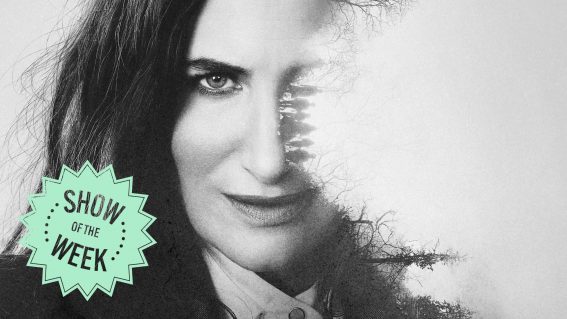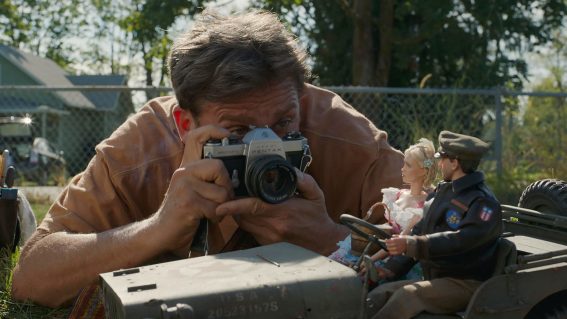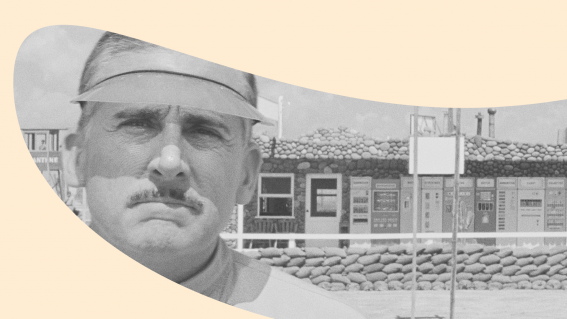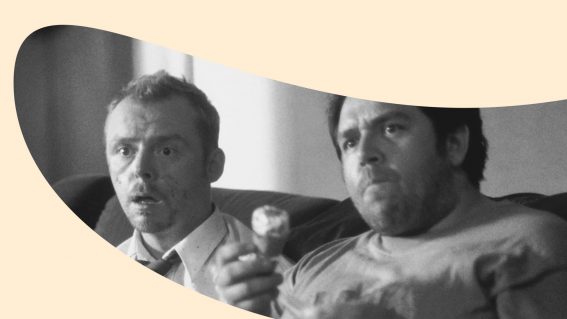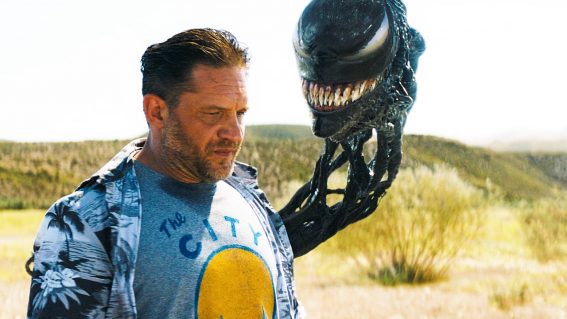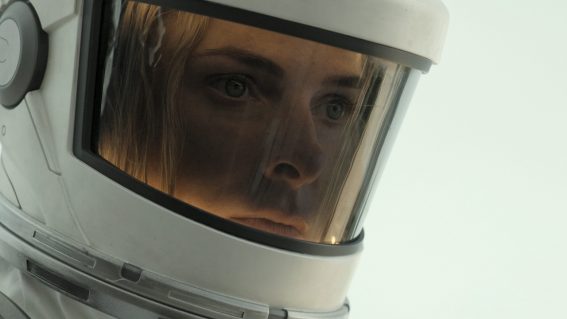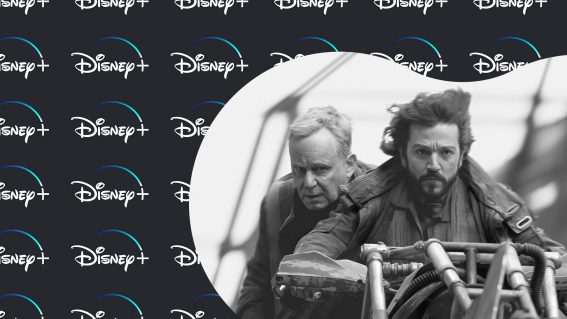How Tumeke Space, the most Kiwi Star Wars ever, was made during lockdown
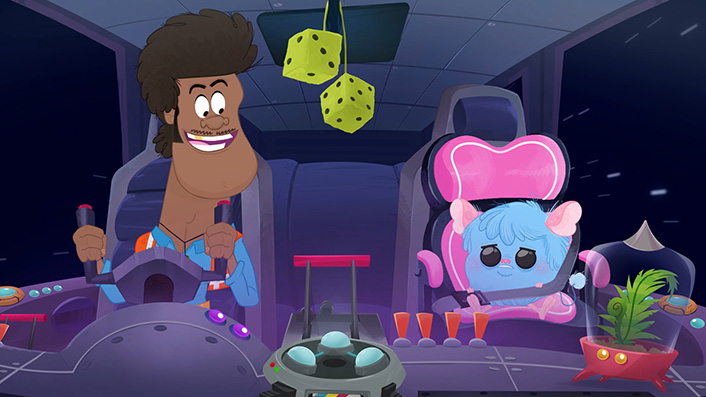
Now streaming on TVNZ On Demand, The Adventures of Tumeke Space is a five-part Kiwi sci-fi comedy epic from local animation giants Mukpuddy. Liam Maguren talks to two of the three co-creators Ryan Cooper and Alex Leighton about animating during lockdown and the show’s ten-year journey from humble post-it note to “the most Kiwi Star Wars we could do.”
THIS INTERVIEW HAS BEEN EDITED FOR LENGTH AND CLARITY
Can you describe each episode in a single word?
Ryan: Oh my God.
Alex: I would say, “Colonisation.” Episode one.
Ryan: Two is… “Chip-n-dip.”
Alex: What is the third? That episode’s got so much. It’s like a heist, it’s like a…
Ryan: “Espionage.”
Episode four… “Gross.”
Alex: Episode five…?
Ryan: “Epic.”
Okay, so… Colonisation, chip-and-dip, espionage, gross, and epic. That covers it?
Ryan: Yep. That’s weirdly to a T.
Alex: It’ll be on the poster.
The moment animation was about to begin on Tumeke Space, the country went into lockdown. Can you take me back to where your minds were in that moment?
Alex: We were filled with dread because we didn’t know if it would work.
Ryan: The fun of being in the same room when you’re kicking off a show, watching the animatic together and having a laugh and discussing it and problem-solving together…
Alex: All of a sudden, [we] became incredibly fractured but everyone was determined to still make this the best thing we’ve ever made. Communication is key, answering any questions that might be coming up, because [that’s] the nature of animating with new rigs and new characters and new voice actors. So aside from just some general slowdown and fatigue, everyone gave it everything they had. It was amazing.
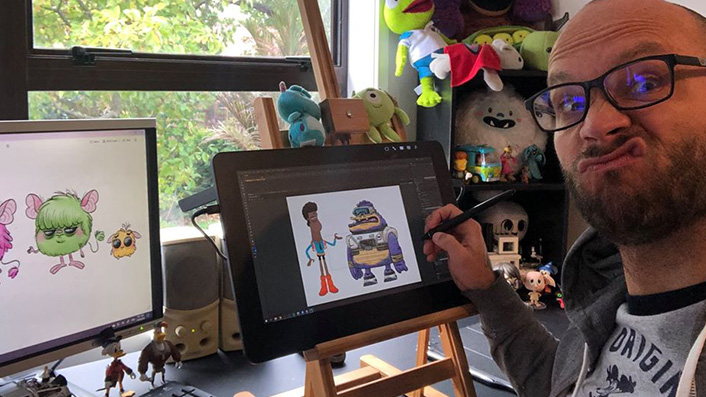
Alex Leighton
The second lockdown in Auckland happened when Tumeke Space was nearing completion. Were you a lot more battle-hardened at that point?
Ryan: I think the message we sent out to the crew was, “We all know how to do this. Let’s just get it done.”
Alex: We needed to instil a solid foundation of communication, making sure everyone’s okay, checking in, chatting with each other.
Ryan: Everyone’s mental health is of the utmost concern here. It’s the way we run. People are important, but this added a new level of pressure on people that we had never dealt with. So making sure that people who would normally feed off other people’s energy were okay, and keeping them motivated, and keeping them…
Alex: …meeting the deadlines [laughter].
Ryan: A lot of artists thrived. The introverts were like, “Here we go! Put me in a room by myself!”
Alex: “I’ve been waiting my whole life for this!”
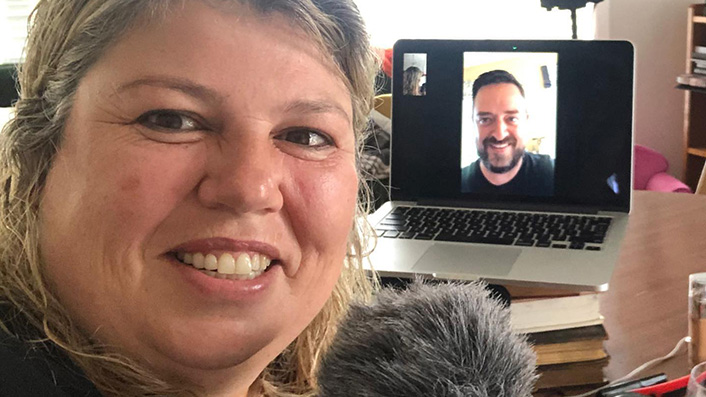
Urzila Carlson (left) & Ryan Cooper (right)
Season one of Barefoot Bandits introduced Tumeke as a kind of washed-up actor past his prime. In season two, we had that long-lost episode. Now we actually have this TV show, so in a way, you reverse-engineered Tumeke Space into being. Was that always the plan?
Alex: We had the idea for Tumeke Space before Bandits. We had a post-it note up for many years that just said, “Tumeke Space.” That name was like, “I know what that is…”
Ryan: A Māori Lando/Han Solo hybrid.
Alex: The most Kiwi Star Wars we could do. That sat there and we thought it was probably a bit too high-concept for New Zealand, not sure that it’ll see the light of day. And then we got the Barefoot Bandits, and we’ve always been a big fan of a show within a show type thing.
Ryan: Doug had Quailman. Simpsons had Itchy and Scratchy.
Alex: We were already erring on the side of an ’80s aesthetic. Bandits‘ heart is firmly in the ’80s. So we were like, “What would be the show that they love?” This is how we got Tumeke Space out there. It allowed us to plant the seed and we knew he would be popular.
Ryan: It sort of sells itself. Especially with Tumeke being about living in the shadow of a family member who’s gone on to do great things and feeling that pressure to achieve greatness but amongst aliens and other planets.
Alex: And we’ve never really tackled sci-fi so much like this and we’re huge sci-fi fans. Star Wars was something that brought our friendship together.
Ryan: There’s no more open brief than sci-fi. So when it came to a brainstorming where Tumeke would get to go, we got to come up with the weirdest things possible.
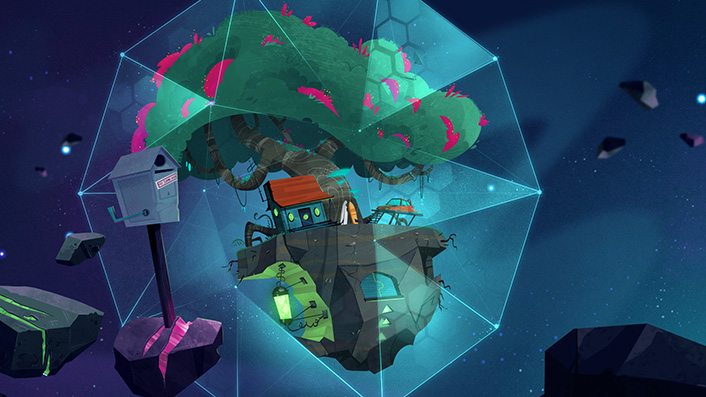
That grimy sci-fi aspect of Star Wars… is that what inspired parts of Tumeke’s design like the reflected jacket and the calculator-watch?
Alex: Yep. That stuff’s a little bit ’80s, but also, everything’s kind of used and reused and has a story…
Ryan: …and a practicality to what he wears. A reflective council vest—it’s for safety. We look at our dads and they have all the safety gears but then wear stubbies, protecting everything but from the thigh to the ankle.
Alex: Those vital veins.
Ryan: There was fun to be found in that aspect of Kiwi culture.
Alex: That lowkey-ness of it, eh? That she’ll-be-right sci-fi. Leaning into that Kiwiness of it.
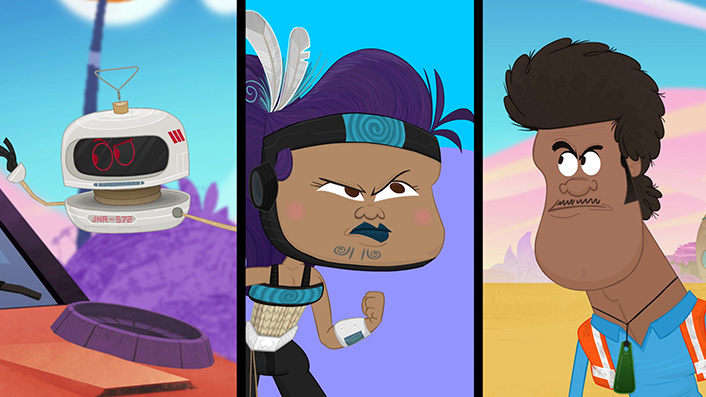
Are there any other inspirations for his personality?
Alex: It sounds cliche but Billy T was definitely a leaping off point. He was so important to us as kids; putting Billy T James in space was just funny to us.
Ryan: A lot of the skits that may have gone over our heads a little bit when we were eight years old, when he was making fun of colonisation and things like that, is a huge part of this show.
It’s what we wanted to bring to the villain in the show. The Pink Menace is very much a Captain Cook-type. Just dabbling with the idea of this sort of monarchy travelling the universe, literally putting gigantic flags and draining everything from the planets they try to take over.
And also, the fun of making a sci-fi cartoon is playing with colours, so we were like, “What if he was bright pink?”
Alex: Three eyes, weird pointy ears, and he’s a fucking sadsack.
Ryan: Our favourite thing to do with villains is to make them incredibly thin-skinned and insecure. The comedy comes pretty quickly. I enjoy voicing that sort of a character.
Then you’ve got this troublemaker, Tumeke Space, always getting in the way. It’s just a nice, simple structure for a show. And in amongst that, we spread in the idea that his koro has been missing for a long time and he believes he’s still alive and he learns a lot about him as the show progresses. Slowly, bit by bit, we reveal little pieces of his past.
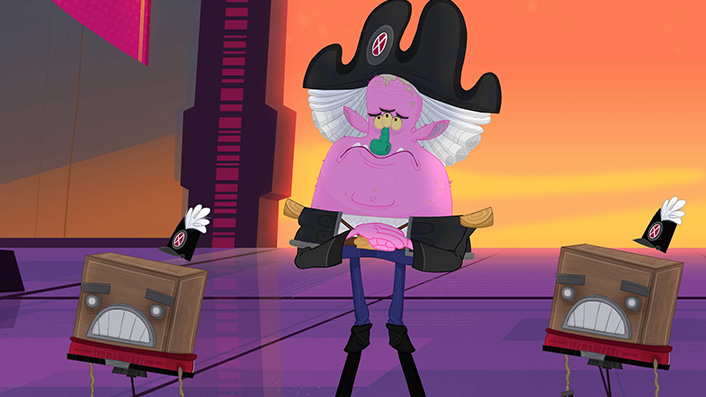
There’s also Wahine Troubles, whose design is more in line with Māori futurism in a way. How did you get her from concept to final character?
Ryan: She was one of our favourite characters straight away. Even when we had her in one or two moments in the Barefoot Bandits, Kura Forrester just brought her to life in such an amazing way.
Alex: Tumeke’s kind of into her, but she doesn’t want a bar of it, but she is every bit of the hero and badass he wants to be but can’t quite because he’s a bit ramshackled. But she’s got all the cool shit.
Ryan: She’s focused. Whereas he’s easily distracted because he also wants to have fun while also being a hero. Whereas she knows how to get the job done but that’s also her flaw because sometimes his goofy solution is the right way.
Alex: And as far as the design is concerned it was kind of like, “What would a badass wahine in space look like? With cool sci-fi gadgets?”
Ryan: But also in the ’80s looking at the future. We’ve come at it from all sorts of ways.
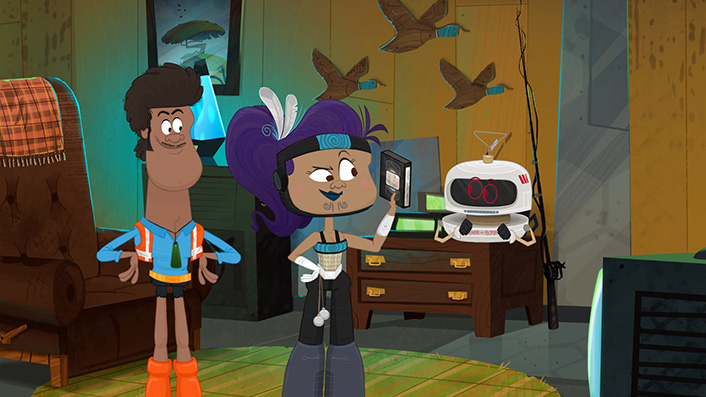
Māori characters are prominent which, on one hand, is great—we need more Māori in space—but on the other hand, there’s always the risk of misrepresenting the culture and the people. How did you contend with that?
Ryan: We consult with our experts. There are culturally important things throughout the series. First and foremost, they’re characters that just happen to be Māori as well, but at the same time, with his missing koro, there is an importance to being Māori that is attached to the characters.
So we have consulted with a few people. Stacey Morrison’s been amazingly helpful as we’ve progressed over the years with Tumeke and developed it. And the actors themselves behind the characters—Glen-Paul Waru and Kura brought personal stuff to the characters. That’s what we want. We want them to bring themselves to these characters so they are more genuine. We’re not guessing—a couple of white dudes taking a wild stab in the dark.
Alex: It’s definitely important to get the representation right. And it’s the only way to do the stories we want to tell justice. We want to make comedies, but good comedy has a lot of heart too. That’s hopefully very present in this story we’re trying to tell.
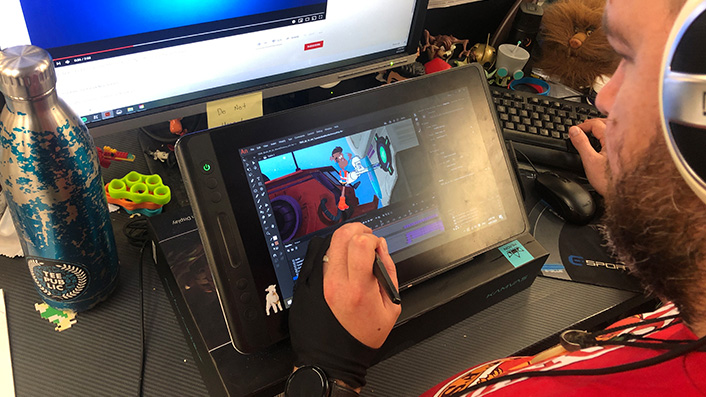
What’s been the biggest fist-pumping or heart-inflating moment for you each on this journey?
Ryan: To be honest, for me, it was writing the last episode of this particular series, when everything you’ve planned falls into place… I was having a little private victory dance when I finished that script. On top of that, seeing this post-it note on our wall for so long as just a single name, to all of the sudden this finished animated series with an amazing score.
Alex: For me, as always, it’s how pretty it looks. I’m super stoked with the work that compositors have done and the background team as well—we have some crazy chase sequences with CG vehicles. And the animation, every stage of it is just so cool to see come together. Every aspect of the production just brought their A-game and we were able to create worlds and planets and space that doesn’t look like anything else I’ve seen.
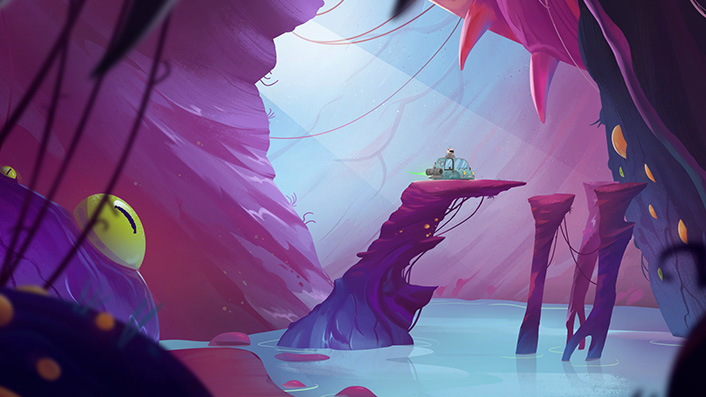
It sounds like everyone’s been given some sort of wiggle room to bring more than what’s expected.
Alex: That’s rewarding for us. It’s fun. If every stage of production, someone gets to add a bit of themselves and go the extra mile because of the freedom, the finished product is all the better for it.
Ryan: And we want to be entertained throughout this process as well. If we were just like, “It must be exactly how we want it…!”
Then you become the Pink Menace.
Yeah, exactly.


